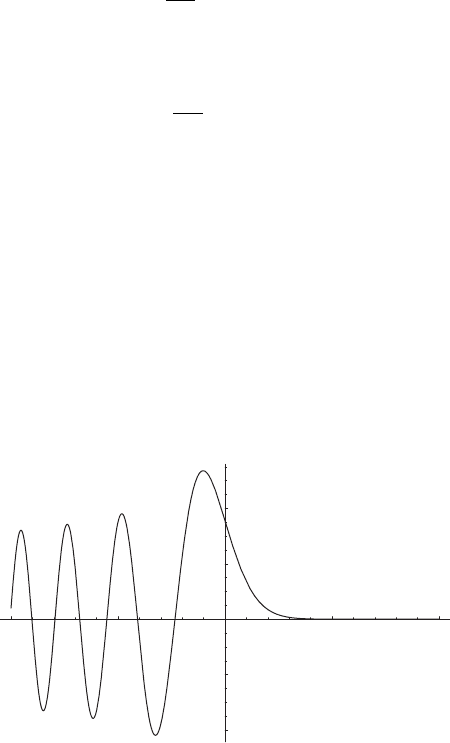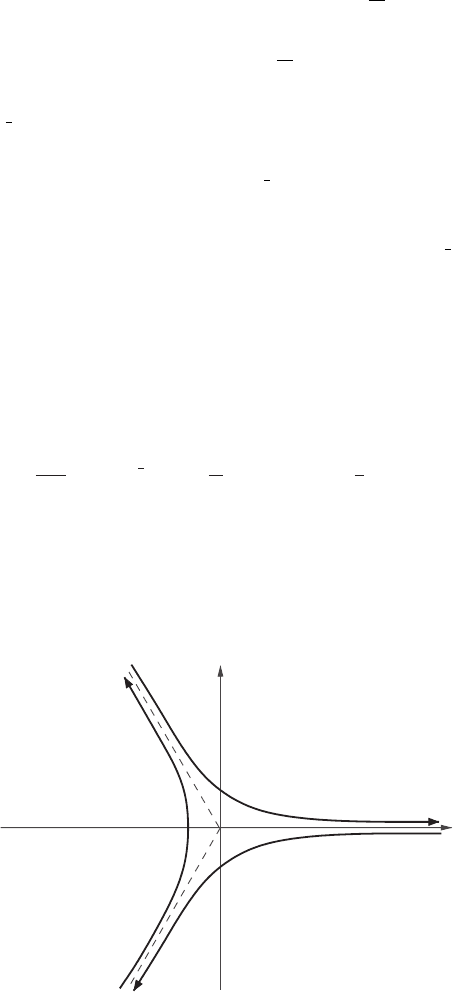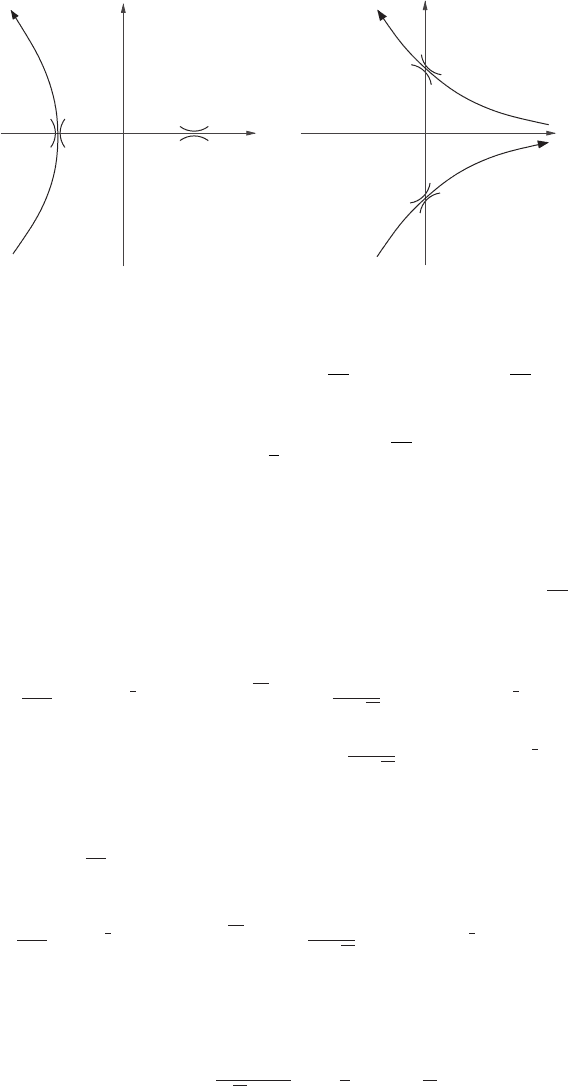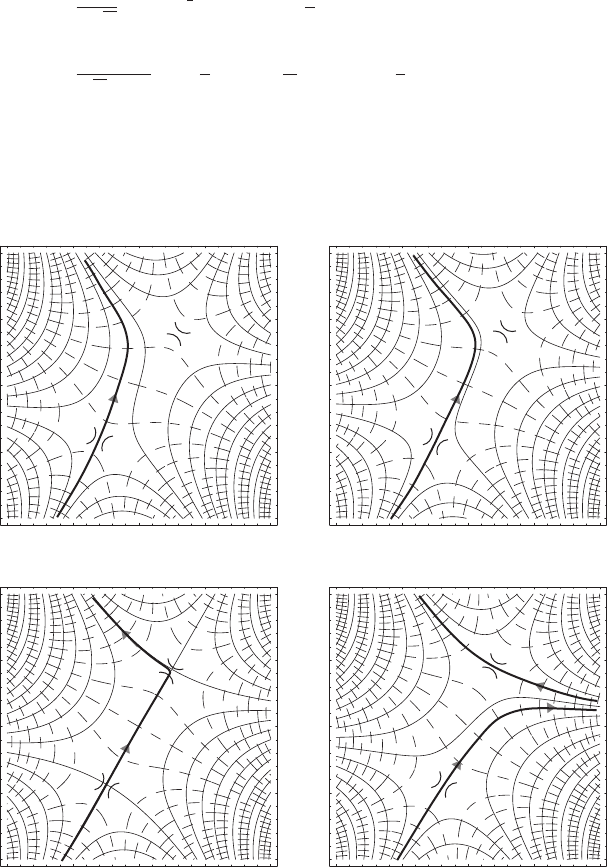Stone M., Goldbart P. Mathematics for Physics: A Guided Tour for Graduate Students
Подождите немного. Документ загружается.


19.4 Asymptotic expansions 725
the Hankel functions by (Figure 19.5)
H
(1)
ν
(z) =
1
iπ
∞+iπ
−∞
e
z sinh
w−νw
dw, |arg z| <π/2
H
(2)
ν
(z) =−
1
iπ
∞−iπ
−∞
e
z sinh w−νw
dw, |arg z| <π/2. (19.105)
Then
1
2
(H
(1)
ν
(z) + H
(2)
ν
(z)) = J
ν
(z),
1
2
(H
(1)
ν
(z) − H
(2)
ν
(z)) = N
ν
(z). (19.106)
19.4 Asymptotic expansions
We often need to understand the behaviour of solutions of differential equations and
functions, such as J
ν
(x), when x takes values that are very large, or very small. This is
the subject of asymptotics.
As an introduction to this art, consider the function
Z(λ) =
∞
−∞
e
−x
2
−λx
4
dx. (19.107)
Those of you who have taken a course in quantum field theory based on path integrals
will recognize that this is a “toy”, 0-dimensional, version of the path integral for the
λϕ
4
model of a self-interacting scalar field. Suppose we wish to obtain the perturbation
expansion for Z(λ) as a power series in λ. We naturally proceed as follows
Z(λ) =
∞
−∞
e
−x
2
−λx
4
dx
=
∞
−∞
e
−x
2
∞
n=0
(−1)
n
λ
n
x
4n
n!
dx
?
=
∞
n=0
(−1)
n
λ
n
n!
∞
−∞
e
−x
2
x
4n
dx
=
∞
n=0
(−1)
n
λ
n
n!
(2n + 1/2). (19.108)
Something has clearly gone wrong here! The Gamma function (2n + 1/2) ∼ (2n)!∼
4
n
(n!)
2
overwhelms the n! in the denominator, so the radius of convergence of the final
power series is zero.

726 19 Special functions and complex variables
The invalid, but popular, manœuvre is the interchange of the order of performing the
integral and the sum. This interchange cannot be justified because the sum inside the
integral does not converge uniformly on the domain of integration. Does this mean that
the series is useless? It had better not! All quantum field theory (and most quantum
mechanics) perturbation theory relies on versions of this manœuvre.
We are saved to some (often adequate) degree because, while the interchange of
integral and sum does not lead to a convergent series, it does lead to a valid asymptotic
expansion. We write
Z(λ) ∼
∞
n=0
(−1)
n
λ
n
n!
(2n + 1/2) (19.109)
where
Z(λ) ∼
∞
n=0
a
n
λ
n
(19.110)
is shorthand for the more explicit
Z(λ) =
N
n=0
a
n
λ
n
+ O
λ
N +1
, N = 1, 2, 3, ... (19.111)
The “big O” notation,
Z(λ) −
N
n=0
a
n
λ
n
= O(λ
N +1
) (19.112)
as λ → 0, means that
lim
λ→0
|Z(λ) −
,
N
0
a
n
λ
n
|
|λ
N +1
|
= K < ∞. (19.113)
The basic idea is that, given a convergent power series
,
n
a
n
λ
n
for the function f (λ),
we fix the value of λ and take more and more terms. The sum then gets closer to f (λ).
Given an asymptotic series, on the other hand, we select a fixed number of terms in
the series and then make λ smaller and smaller. The graph of f (λ) and the graph of
our polynomial approximation then approach each other. The more terms we take, the
sooner they get close, but for any non-zero λ we can never get exacty f (λ) – no matter
how many terms we take.
We often consider asymptotic expansions where the independent variable becomes
large. Here we have expansions in inverse powers of x:
F(x) =
N
n=0
b
n
x
−n
+ O
x
−N −1
, N = 1, 2, 3, ... (19.114)

19.4 Asymptotic expansions 727
In this case
F(x) −
N
n=0
b
n
x
−n
= O
x
−N −1
(19.115)
means that
lim
x→∞
|F(x) −
,
N
0
b
n
x
−n
|
|x
−N −1
|
= K < ∞. (19.116)
Again we take a fixed number of terms, and as x becomes large the function and its
approximation get closer.
Observations:
(i) Knowledge of the asymptotic expansion gives us useful knowledge about the func-
tion, but does not give us everything. In particular, two distinct functions may have
the same asymptotic expansion. For example, for small positive λ, the functions
F(λ) and F(λ) + ae
−b/λ
have exactly the same asymptotic expansions as series in
positive powers of λ. This is because e
−b/λ
goes to zero faster than any power of
λ, and so its asymptotic expansion
,
n
a
n
λ
n
has every coefficient a
n
being zero.
Physicists commonly say that e
−b/λ
is a non-perturbative function, meaning that it
will not be visible to a perturbation expansion in powers of λ.
(ii) An asymptotic expansion is usually valid only in a sector a < arg z < b in the
complex plane. Different sectors have different expansions. This is called the Stokes
phenomenon.
The most useful methods for obtaining asymptotic expansions require that the function
to be expanded be given in terms of an integral. This is the reason why we have stressed
the contour-integral method of solving differential equations. If the integral can be
approximated by a Gaussian, we are led to the method of steepest descents. This technique
is best explained by means of examples.
19.4.1 Stirling’s approximation for n!
We start from the integral representation of the Gamma function:
(x + 1) =
∞
0
e
−t
t
x
dt. (19.117)
Set t = xζ ,so
(x + 1) = x
x+1
∞
0
e
zxf (ζ )
dζ , (19.118)
where
f (ζ ) = ln ζ − ζ . (19.119)

728 19 Special functions and complex variables
We are going to be interested in evaluating this integral in the limit that x →∞and
finding the first term in the asymptotic expansion of (x + 1) in powers of 1/x. In this
limit, the exponential will be dominated by the part of the integration region near the
absolute maximum of f (ζ ). Now, f (ζ ) is a maximum at ζ = 1 and
f (ζ ) =−1 −
1
2
(ζ − 1)
2
+··· (19.120)
so
(x + 1) = x
x+1
e
−x
∞
0
e
−
x
2
(ζ −1)
2
+···
dζ
≈ x
x+1
e
−x
∞
−∞
e
−
x
2
(ζ −1)
2
dζ
= x
x+1
e
−x
<
2π
x
=
√
2π x
x+1/2
e
−x
. (19.121)
By keeping more of the terms represented by the dots, and expanding them as
e
−
x
2
(ζ −1)
2
+···
= e
−
x
2
(ζ −1)
2
7
1 + a
1
(ζ − 1) + a
2
(ζ − 1)
2
+···
8
, (19.122)
we would find, on doing the integral, that
(z + 1) ≈
√
2πx
x+1/2
e
−x
1 +
1
12x
+
1
288x
2
−
139
51840x
3
−
571
24888320x
4
+ O
1
x
5
. (19.123)
Since (n + 1) = n! we have the useful result
n!≈
√
2πn
n+1/2
e
−n
1 +
1
12n
+···
. (19.124)
We make contact with our discusion of asymptotic series by rewriting the expansion as
(x + 1)
√
2πx
x+1/2
e
−x
∼ 1 +
1
12x
+
1
288x
2
−
139
51840x
3
−
571
24888320x
4
+ ... (19.125)

19.4 Asymptotic expansions 729
This is typical. We usually have to pull out a leading factor from the function whose
asymptotic behaviour we are studying, before we are left with a plain asymptotic power
series.
19.4.2 Airy functions
TheAiry functions Ai(x) and Bi(x) are closely related to Bessel functions, and are named
after the mathematician and astronomer George Biddell Airy. They occur widely in
physics. We will investigate the behaviour of Ai(x) for large values of |x|. A more sophis-
ticated treatment is needed for this problem, and we will meet with Stokes’phenomenon.
Airy’s differential equation is
d
2
y
dz
2
− zy = 0. (19.126)
On the real axis Airy’s equation becomes
−
d
2
y
dx
2
+ xy = 0, (19.127)
and we can think of this as the Schrödinger equation for a particle running up a linear
potential. A classical particle incident from the left with total energy E = 0 will come
to rest at x = 0, and then retrace its path. The point x = 0 is therefore called a classical
turning point. The corresponding quantum wavefunction, Ai (x), contains a travelling
wave incident from the left and becoming evanescent as it tunnels into the classically for-
bidden region, x > 0, together with a reflected wave returning to −∞ (see Figure 19.6).
The sum of the incident and reflected waves is a real-valued standing wave.
We will look for contour integral solutions to Airy’s equation of the form
y (x) =
C
e
xt
f (t) dt. (19.128)
–10 –5 5 10
–0.4
–0.2
0.2
0.4
Figure 19.6 The Airy function Ai (x).

730 19 Special functions and complex variables
Denoting the Airy differential operator by L
x
≡ ∂
2
x
− x, we have
L
x
y =
C
(t
2
− x)e
xt
f (t) dt =
b
a
f (t)
t
2
−
d
dt
e
xt
dt.
=
−e
xt
f (t)
C
+
C
t
2
+
d
dt
f (t)
e
xt
dt. (19.129)
Thus f (t) = e
−
1
3
t
3
and hence
y (x) =
C
e
xt−
1
3
t
3
dt, (19.130)
provided the contour ends at points where the integrated-out term,
7
e
xt−
1
3
t
3
8
C
, vanishes.
There are therefore three possible contours, shown in Figure 19.7, which end at any two of
+∞, ∞e
2πi/3
, ∞e
−2πi/3
.
Since the integrand is an entire function, the sum y
C
1
+ y
C
2
+ y
C
3
is zero, so only two
of the three solutions are linearly independent. The Airy function itself is defined by
Ai (x) =
1
2πi
C
1
e
xt−
1
3
t
3
dt =
1
π
∞
0
cos
xs +
1
3
s
3
ds. (19.131)
In obtaining the last equality, we have deformed the contour of integration, C
1
, which
ran from ∞e
−2πi/3
to ∞e
2πi/3
, so that it lies on the imaginary axis, and there we have
written t = is. You may check (by extending Jordan’s lemma) that this deformation does
not alter the value of the integral.
C
1
C
2
C
3
Figure 19.7 Contours providing solutions of Airy’s equation.

19.4 Asymptotic expansions 731
To study the asymptotics of this function we need to examine separately two cases
x 0 and x 0. For both ranges of x, the principal contribution to the integral will
come from the neighbourhood of the stationary points of f (t) = xt −t
3
/3. In the complex
plane, stationary points are never pure maxima or minima of the real part of f (the real part
alone determines the magnitude of the integrand) but are always saddle points. We must
deform the contour so that on the integration path the stationary point is the highest point
in a mountain pass. We must also ensure that everywhere on the contour the difference
between f and its maximum value stays real. Because of the orthogonality of the real
and imaginary part contours, this means that we must take a path of steepest descent
from the pass – hence the name of the method. If we stray from the steepest descent path,
the phase of the exponent will be changing. This means that the integrand will oscillate
and we can no longer be sure that the result is dominated by the contributions near the
saddle point.
(i) x 0: The stationary points are at t =±
√
x. Writing t = ξ −
√
x we have
f (ξ) =−
2
3
x
3/2
+ ξ
2
√
x −
1
3
ξ
3
, (19.132)
while near t =+
√
x we write t = ζ +
√
x and find
f (ζ ) =+
2
3
x
3/2
− ζ
2
√
x −
1
3
ζ
3
. (19.133)
We see that the saddle point near −
√
x is a local maximum when we route the
contour vertically, while the saddle point near +
√
x is a local maximum as we go
down the real axis. Since the contour in Ai (x) is aimed vertically we can distort it
to pass through the saddle point near −
√
x, but cannot find a route through the point
at +
√
x without the integrand oscillating wildly. At the saddle point the exponent,
xt − t
3
/3, is real. If we write t = u + iv we have
Im (xt − t
3
/3) = v(x −u
2
+ v
2
/3), (19.134)
so the exact steepest descent path, on which the imaginary part remains zero, is
given by the union of the real axis (v = 0) and the curve
u
2
−
1
3
v
2
= x. (19.135)
This is a hyperbola, and the branch passing through the saddle point at −
√
x is
plotted in Figure 19.8(a).
Now setting ξ = is, we find
Ai (x) =
1
2π
e
−
2
3
x
3/2
∞
−∞
e
−
√
xs
2
+···
ds ∼
1
2
√
π
x
−1/4
e
−
2
3
x
3/2
. (19.136)

732 19 Special functions and complex variables
(b)(a)
u
v
v
u
Figure 19.8 Steepest descent contours, location of the stationary points and orientation of the
saddle passes for (a) x 0, (b) x 0.
(ii) x 0: The stationary points are now at ±i
√
|x|. Setting t = ξ ±i
√
|x| we find that
f (x) =∓i
2
3
|x|
3/2
∓ iξ
2
|x|. (19.137)
The exponent is no longer real, but the imaginary part will be constant and the
integrand non-oscillatory provided we deform the contour so that it becomes the
disconnected pair of curves shown in Figure 19.8(b). The new contour passes through
both saddle points and we must sum their contributions. Near t = i
√
|x| we set
ξ = e
3πi/4
s and get
1
2πi
e
3πi/4
e
−i
2
3
|x|
3/2
∞
−∞
e
−
√
|x|s
2
ds =
1
2i
√
π
e
3πi/4
|x|
−1/4
e
−i
2
3
|x|
3/2
=−
1
2i
√
π
e
−iπ/4
|x|
−1/4
e
−i
2
3
|x|
3/2
.
(19.138)
Near t =−i
√
|x| we set ξ = e
πi/4
s and get
1
2πi
e
πi/4
e
i
2
3
|x|
3/2
∞
−∞
e
−
√
|x|s
2
ds =
1
2i
√
π
e
πi/4
|x|
−1/4
e
i
2
3
|x|
3/2
. (19.139)
The sum of these two contributions is
Ai (x) ∼
1
√
π|x|
1/4
sin
2
3
|x|
3/2
+
π
4
. (19.140)

19.4 Asymptotic expansions 733
The fruit of our labours is therefore
Ai (x) ∼
1
2
√
π
x
−1/4
e
−
2
3
x
3/2
1 + O
1
x
, x > 0,
∼
1
√
π|x|
1/4
sin
2
3
|x|
3/2
+
π
4
1 + O
1
x
, x < 0. (19.141)
Suppose that we allow x to become complex x → z =|z|e
iθ
, with −π<θ<π.
Then Figure 19.9 shows how the steepest contour evolves and leads to two quite different
–2 –1 0 1 2
–2
–1
0
1
2
–2 –1 0 1 2
–2
–1
0
1
2
–2 –1 0 1 2
–2
–1
0
1
2
–2 –1 0 1 2
–2
–1
0
1
2
(a)
(b)
(c)
(d)
Figure 19.9 Evolution of the steepest-descent contour from passing through only one saddle
point to passing through both. The dashed and solid lines are contours of the real and imaginary
parts, repectively, of (zt − t
3
/3). θ = Arg z takes the values (a) 7π/12, (b) 5π/8, (c) 2π/3,
(d) 3π/4.

734 19 Special functions and complex variables
expansions for positive and negative x. We see that for 0 <θ<2π/3 the steepest descent
path continues to be routed through the single stationary point at −
√
|z|e
iθ/2
. Once θ
reaches 2π/3, though, it passes through both stationary points. The contribution to the
integral from the newly acquired stationary point is, however, exponentially smaller as
|z|→∞than that of t =−
√
|z|e
iθ/2
. The new term is therefore said to be subdominant,
and makes an insignificant contribution to the asymptotic behaviour of Ai (z). The two
saddle points only make contributions of the same magnitude when θ reaches π.Ifwe
analytically continue beyond θ = π, the new saddle point will now dominate over the
old, and only its contribution is significant at large |z|. The Stokes line, at which we must
change the form of the asymptotic expansion, is therefore at θ = π.
If we try to systematically keep higher order terms we will find, for the oscillating
Ai (−z), a double series
Ai (−z) ∼ π
−1/2
z
−1/4
%
sin(ρ + π/4)
∞
n=0
(−1)
n
c
2n
ρ
−2n
−cos(ρ + π/4)
∞
n=0
(−1)
n
c
2n+1
ρ
−2n−1
&
(19.142)
where ρ = 2z
3/2
/3. In this case, therefore, we need to extract two leading coefficients
before we have asymptotic power series.
The subject of asymptotics contains many subtleties, and the reader in search of
a more detailed discussion is recommended to read Bender and Orszag’s Advanced
Mathematical Methods for Scientists and Engineers.
Exercise 19.2: Consider the behaviour of Bessel functions when x is large. By applying
the method of steepest descent to the Hankel function contours show that
H
(1)
ν
(x) ∼
<
2
πx
e
i(x−νπ/2−π/4)
1 −
4ν
2
− 1
8πx
+···
H
(2)
ν
(x) ∼
<
2
πx
e
−i(x−νπ/2−π/4)
1 +
4ν
2
− 1
8πx
+···
,
and hence
J
ν
(x) ∼
<
2
πx
cos
x −
νπ
2
−
π
4
−
4ν
2
− 1
8x
sin
x −
νπ
2
−
π
4
+···
,
N
ν
(x) ∼
<
2
πx
sin
x −
νπ
2
−
π
4
+
4ν
2
− 1
8x
cos
x −
νπ
2
−
π
4
+···
.
